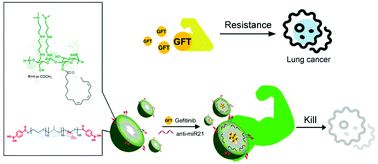Chitosan-derived nanoparticles impede signal transduction in T790M lung cancer therapy†
Abstract
Epidermal growth factor receptor tyrosine kinase inhibitors (EGFR-TKIs) treated patients ultimately develop disease progression, about 50% of which are involved in the emergence of a p.Thr790Met (T790M) mutation acquiring drug resistance. In order to solve the aforementioned problem, a therapeutic nanoparticles DGA is developed to overcome EGFR-T790M resistance via downstream anti-apoptotic signal transduction blocking by a combination with persuading mitochondrial dysfunction and inhibiting miRNA expression. As the concept of design, chitosan-derived nanocarrier DCAFP, capable of persuading mitochondrial dysfunction, is demonstrated to convey gefitinib (GFT) and miR21 inhibitor (anti-miR21) to form DGA nanoparticles. The superior accumulation of antitumor therapeutics and synergistic blocking of downstream signal transduction by mitochondrial dysfunction and miRNA regulation lead to high sensitivity of DGA nanoparticles to EGFR-T790M mutated non-small cell lung cancer (NSCLC) cells with significant inhibition of tumor cell growth. The in vivo study demonstrates superior safety and antitumor efficacy of EGFRT790M mutated lung cancer mouse models. These results highlight the promise of DGA nanoparticles for enhancing GFT sensitivity to EGFRT790M NSCLC.



 Please wait while we load your content...
Please wait while we load your content...